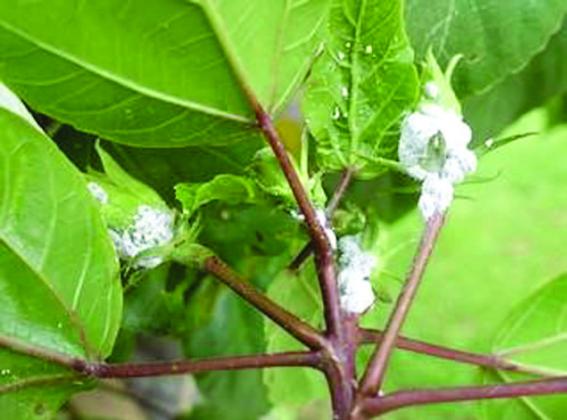Presented by UF-IFAS Extension Services Osceola County
Pests are an inevitable hurdle that plant owners must come to face. Just like your furry friends, plants can also suffer from bug infestations and diseases. Use this quick guide as reference to recognize and treat any infestation that occurs during the life cycle of your plants indoors and outdoors.
Quarantine: Some stores do not spray their plants with any type of insecticide, so the soil could be infested with many types of bugs or soil contaminations. For one to two weeks, keep new plants in a different area of your house, or outside if it is warm. If you see any insects in this time, take the appropriate actions to treat the cause. This will prevent any infestations from occurring to your existing collection of plants.
Some culprits: Mealybugs: usually appear on the steams around the nodes of the plant, they are white and fluffy, mature bugs resemble suds.
Spider mites: appear in the soil; they are deep brown in color, but can also be green, yellow, or red. If you look closely at the soil, it will look like appears to be ants moving around on the soil. Avoid fertilizing during this time. This can accelerate the growth cycle of the insect.
Aphids: appear on the nodes of the stem, a greenlight brown soft-shelled xylem sucker.
Thrips: appear on the flowers and new leaves in which they feed on. They thrive in warmer environments. They are black/brown with thin wings; the leaves will look transparent or like they were splashed with bleach. Soon black dots will appear; this is their waste, another sign of thrips being present.
Fungus gnats: appear in the soil and fly around the area near the plant and within the home. These flyers appear with consistent overwatering.
Leaf miners: These black flies lay their young in the leaves under the cuticle layer. The young, in a larval stage, eat the leaves from the inside out in a mine like pattern which they get their name from. A mosaic like pattern will appear in the leaves.
Scale: There are two types. One is hard shelled and sits in one place on the stem and leaves to feed. The other type is soft shelled; they look transparent and move about the plant while leaving a sticky residue behind called ‘Honeydew.’ They reproduce very quickly, so getting them under control will be crucial to the survival of your houseplants.
Shore flies: These bugs look similar to gnats but tend to hang around puddled water or algae growing on soil or surfaces, to prevent these bugs be sure to not overwater. Do not allow anything to grow that is not the plant. If you see any weeds remove them immediately. Weeds are considered as vectors, a plant that can transfer disease or attract insects, shore flies being one of those pests.
White flies: appear on the underside of leaves and stunt the growth of them. The leaves will look disfigured. These will fly around the plant when it is disturbed. They are mostly present in Christmas plants coming from a large greenhouse; be careful with holiday plants.
Prevention and Elimination: When treating an infestation of pest in your houseplants, it is highly recommended that you try an organic method first: Neem Oil, Diatomaceous Earth, Apple Cider Vinegar solutions, Insecticidal Soap, and sticky cards.
If your pest problem is too far-gone that those methods have not worked, it is time to bring in the chemicals. Before using any chemicals, READ THE ENTIRE LABEL attached to the back and follow the instructions carefully. Be sure to wear the appropriate PPE (Personal Protective Equipment) when applying chemicals.
Some examples are Sevin Dust, Systemic controls, and household bug spray (for flyers).
For more information, contact Christine Jackson, at cjackson8@ufl.edu or call 321-697-3000. For more information about all our programs, visit us at http://sfyl.ifas.ufl.edu/osceola/.




